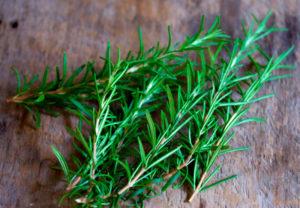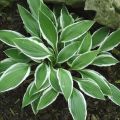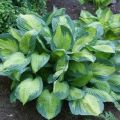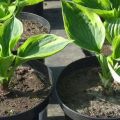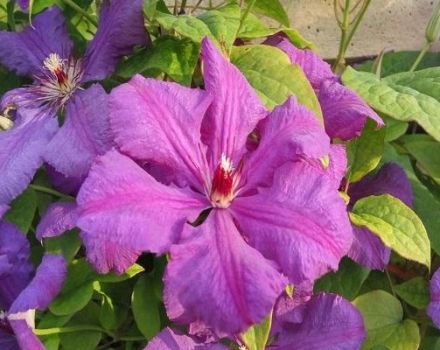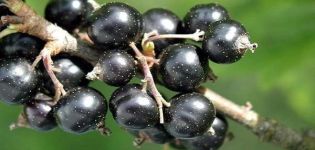Signs of hosta disease and pest infestation, treatment and prevention
Summer residents and gardeners choose the host for the original appearance, unpretentious care. To maintain the decorativeness of the culture at the proper level, they create favorable conditions, study the signs of diseases of the hosts, methods of treatment.
Plant characteristic
A plant native to Japan, used in landscaping shady gardens, attracts with various patterns on the leaves. Growing hosts does not provide for bright light, so the culture occupies shady areas that are unsuitable for other plants.
Gardeners are attracted by the variety of leaf shapes located on long stems and colors ranging from milky to purple.
There are up to 4 thousand varieties of hostas with leaf length from 10 cm to 1 m.
Of the popular varieties in demand in Europe and Russia, there are:
- Alex Summers with a gold stripe along the edge and a bluish tint;
- Moon of Augustus with yellow leaves;
- First Frost is a chameleon variety that changes color from blue to green;
- Capitance Adventure, characterized by an unusual "waffle" structure of oval sheet plates;
- Allegan Fogh with twisted white and green leaves.
Hosta, belonging to the genus Agave, is a perennial herb. The flowering period extends from June to September. When the bell-shaped flowers, painted in white, purple, lilac tones, fade, boxes with seeds are formed.
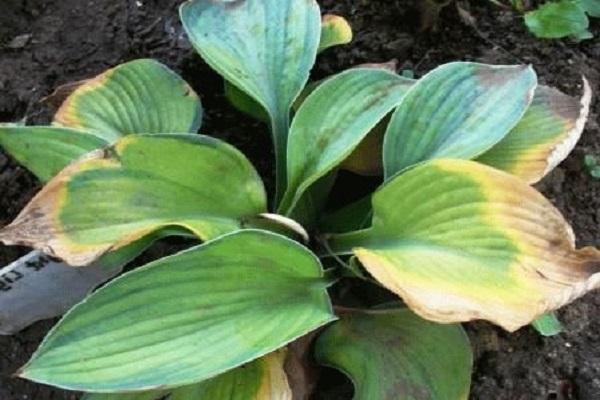
Every year the culture increases its green mass and looks like an island with tropical vegetation.
The decorativeness of the hosts is reduced by sun, frost burns, pests and diseases that are difficult to immediately identify due to the thickening of the bushes.
Diseases
High summer temperatures together with high humidity, excess nitrogen in the soil lead to fungal diseases. Along with rot and spots, the culture is affected by a specific virus that develops only on the host.
Viruses X, HVX
Hosta Virus X (HVX) was discovered by American scientist Lockhart at the end of the 20th century. The disease is transmitted through the juice that got on the garden tools or hands during the cutting of leaves, dividing the bush. When touching healthy plants with a non-disinfected hoe or unwashed hands, the virus penetrates through the sections and wounds into the tissue of the culture, begins to feed and multiply.
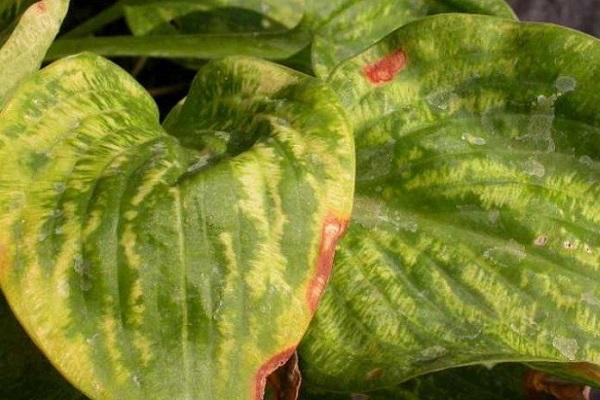
Signs
Before the discovery of the virus, yellow spots, small blotches, strokes, rings were mistaken for the unusual coloration of the host. But later, it became clear that this is a disease leading to insufficient growth, curling of leaves.
Distinctive features of Hosta Virus X (HVX):
- different density of tissues, heterogeneous color in areas of one sheet;
- the effect of "spreading ink" on the veins of the leaf plates - interveinal chlorosis;
- vague spots, mosaic;
- slowing down the development of the bush, dwarfism;
- change in color of flowers, lack of ovary.
Resistant to the Siebold host virus and its hybrids, but this fact does not guarantee the elimination of the risk of disease.
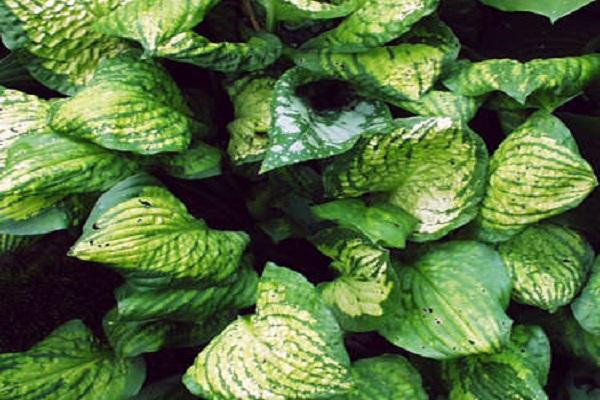
Treatment methods
If a virus is detected, it makes no sense to save the plant, since the disease does not respond to treatment, spreads to all parts of the host, gradually leading the plant to death. It is advisable to burn the sick host, soak the inventory in formalin or in a manganese solution.

Phylostictosis
Both indoor and garden crops are susceptible to phylosticosis or brown spot. Phyllosticta fungus thrives at excessive humidity and air temperatures above 25 ° C.
How to determine
A characteristic sign of the introduction and spread of the fungus is the formation of brown spots with black dots. The affected areas of the hosts dry up and die off. The advanced stage of Phylosticosis leads to the death of the plant.
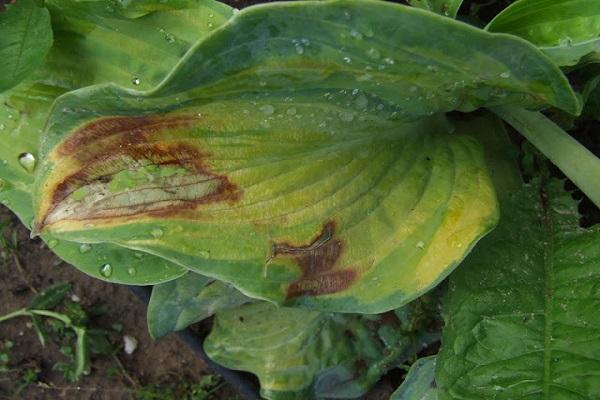
How to treat
Leaves and peduncles with foci of fungal spores are burned, reducing the frequency and volume of irrigation of the hostas. If the plant is severely affected, remove the entire crop.
Since the disease is easily transmitted to neighboring plants, the diseased host is transplanted to a separate area. Brown spot is fought by spraying every 10 days before flowering. Fungicides Strobi, Vectra, copper sulfate are suitable for processing hosts. Experienced gardeners use a colloidal sulfur solution prepared from half a glass of dry matter and 10 liters of water.

Gray rot
Gray rot mushrooms are omnivorous. They affect herbaceous plants, flower and fruit crops. The disease is not only common, but also dangerous. If you do not take action in time, the plant will die. The botrite fungus forms a mycelium on culture with a large number of spores, which fall on neighboring plants with the wind.
Signs
Signs of gray rot are distinguished depending on the stage of development of the disease.
initial stage
Spores of the fungus Botrytis are manifested by the appearance of an ash deposit, decay, deformation and drying of the tops and edges of the leaf plate. In the early, treatable stages, part of the leaf dies off.
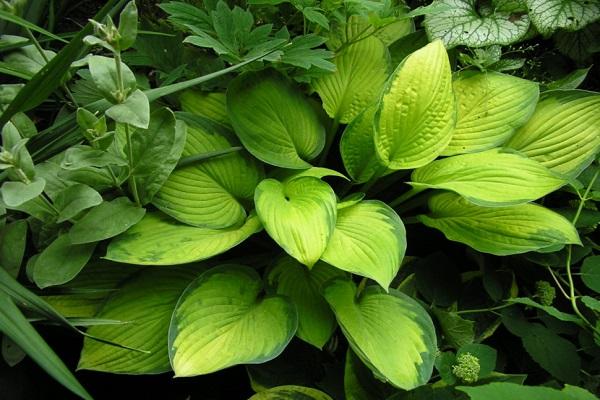
Neglected case
In advanced cases, gray rot spreads over the entire area of the plate and stem, which subsequently dry up, lie on the ground and crumble. In this case, the plant is removed from the ground and destroyed.
Treatment methods
Gray rot is easier to prevent than to cure. The first tillage is carried out in early spring with the first loosening of the soil. The planting sites are sprayed from a spray bottle with contact preparations based on copper (Abiga-peak, Hom, Oksikhom).
After the appearance of the first leaves, spraying is carried out with systemic agents - Acrobat, Previkur, Profit Gold, Fundazol, Skor. After 2 weeks, the event is repeated.
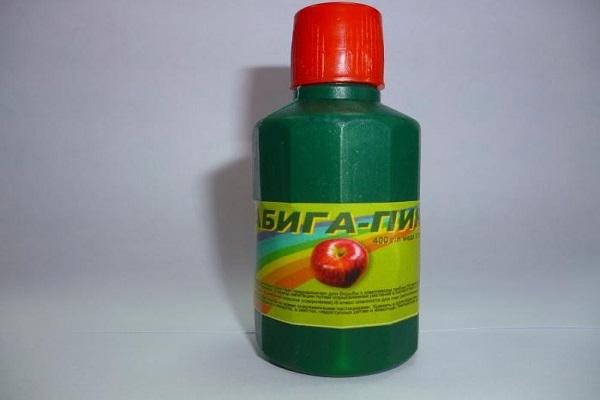
If preventive measures are not followed, and the first signs of the development of the fungus Botrytis are visible on the leaves, the hosts immediately begin to process the hosts with Fundazol, Topaz, Ridomil Gold.
At the end of the growing season, plant residues are collected and burned.
Root collar rot
The disease is caused by various types of fungi that develop rapidly in thickened shady plantings with excessive moisture and buried rhizomes.
How to diagnose
Root collar rot is recognized by the discoloration of the leaves. The plates first turn yellow from the edges to the center, maintaining their density, then discolor and dry out. If you pull on the stem, the leaf will fall off, exposing the root collar with a characteristic bloom.
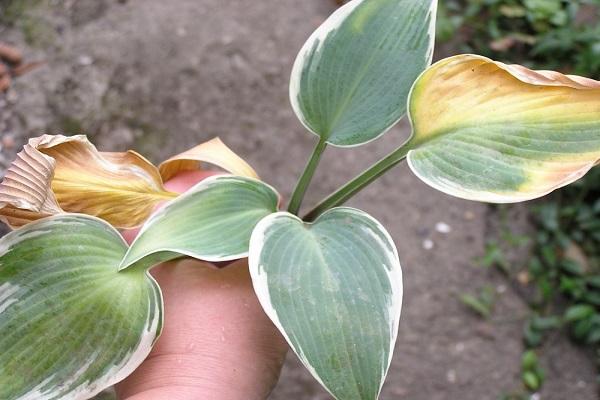
How can you cure
To combat and prevent root rot, a solution is poured under the root, consisting of 1 tbsp. l. Previkura and a liter of water. Treatment of bushes with the following preparations is effective:
- biologically active Fitolavin, Trichovit, to a greater extent helping young plants;
- Trichodermin, acting on a wide range of fungal and bacterial diseases;
- Topaz - a means of systemic action;
- medium toxicity by Maxim;
- Mikosan, which forms the host's immune defense.
Spraying with copper sulfate and Bordeaux liquid are effective.
But it's best not to risk the health of the culture. When the first leaf turns yellow, the hosta is removed from the soil, the rhizome is washed, and examined for rot. The affected areas are cut with a sharp knife, the sections are treated with fungicides or crushed activated carbon. Leave the sick host for 1-2 hours for drying, then put in a separate container.
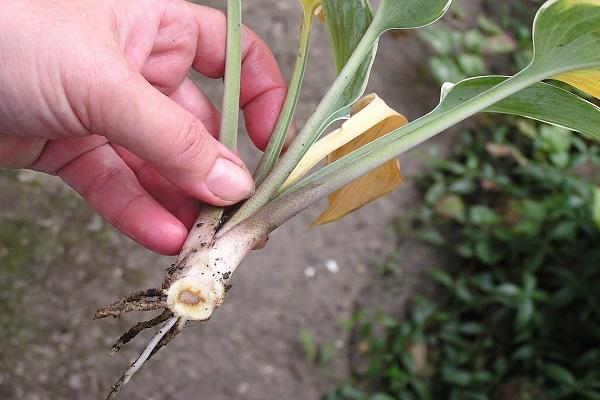
Rust
Rust more often affects hosta varieties with a yellow border during dry periods with insufficient watering. The disease dries up the leaves, disrupts metabolism, the process of photosynthesis.
None of the measures taken will return the decorative effect to the plant. To prevent the loss of moisture by leaf plates, the culture is planted in the shade, the soil is not allowed to dry out.
Pests
More often than diseases, the host is harmed by attacks from slugs, beetles, caterpillars, leaf nematodes and rodents.
Slugs and snails
To a greater extent, undersized thin-leaved hosta varieties are attacked by slugs and snails. Some leaves of the crop, located close to the soil, only show up from the ground, as they are already being overestimated by pests. As a result, after the sprout has blossomed, holes are visible on the leaf plate. The sticky silvery lines of mucus on the host signal an attack by gastropods.

Pest control begins in early spring, sprinkling the ground with ash, tobacco, pouring vinegar, setting beer traps. You can place wet cardboard sheets or newspapers under the bushes, and in the morning you can collect the mollusks that have accumulated under the objects. If folk remedies do not bring results, use drugs Thunderstorm, Bros from slugs, Slime-eater. The granules are placed under each bush three times over the summer.
Beetles and caterpillars
Beetles, grasshoppers, caterpillars are capable of causing great damage to the host. Insects eat leaves from the edges, gnaw holes. Harm stems, damage buds and blossoming flowers. If there are few insects, mechanical collection by sprinkling irrigation is effective. When the plant is threatened, the host is treated with Karbofos, Iskra, Intavir. Since the pupae hibernate in the ground, for prevention, they dig up the soil in the fall.
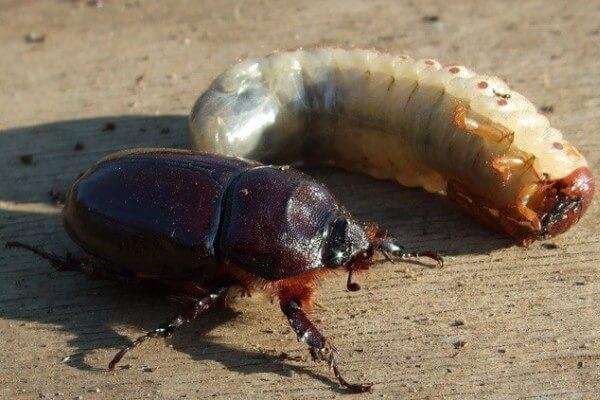
Deciduous nematodes
Microscopic roundworms of the genus Aphelenchoides up to 1 mm in length penetrate through lesions and orifices located on the wrong side of the leaf. Brown streaks remain in the path of parasitic activity. Later, the leaves stop developing and dry up.
Folk remedies are powerless in the fight against nematodes. The only effective way to disinfect the land where insects hibernate is to spill the soil with boiling water to a depth of 20 cm, cover with a film for slow cooling.
From chemical preparations, gardeners secrete contact and systemic poisons with which they spray the bushes:
- Dimethoate;
- Karbofos;
- Lindane;
- Phosphamide.
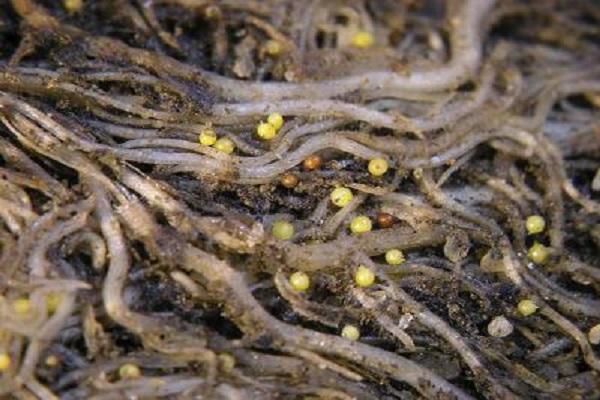
Since the listed funds are toxic, follow the instructions for use.
Rodents
To protect the stems and roots of the culture, covered with mulch for the winter, from the teeth of rodents, the hosta is buried in the ground together with a metal fine mesh fixed around the rhizome, and poisonous baits are scattered nearby.

Treatment and prevention of the most common hosta disease
The most common disease of the Hosta Virus X (HVX) culture is not treatable. In order not to contaminate healthy plants, after use, garden tools are treated in a disinfectant solution.
It is difficult to exclude the virus from entering the garden, but you can reduce the risks.
It is recommended to choose planting material in proven nurseries and compare the leaf pattern of the proposed plant with the image of the variety in the catalog. If there is a mosaic, strokes, spots on the leaf plate that are not declared for this variety, then the plant cannot be purchased.
